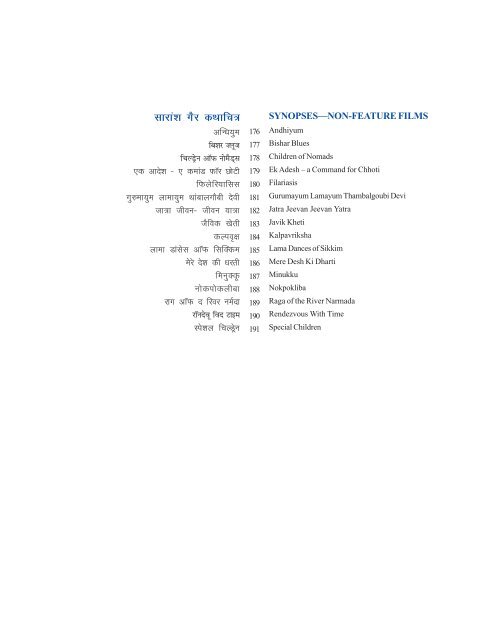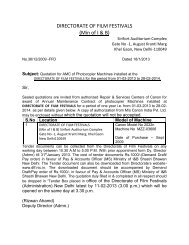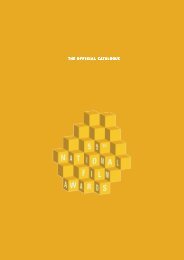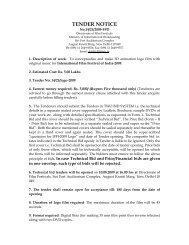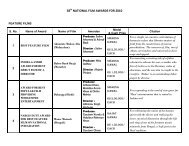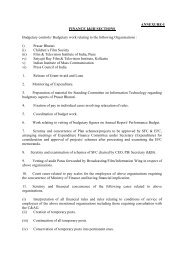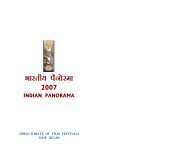best feature film - Directorate of Film Festivals
best feature film - Directorate of Film Festivals
best feature film - Directorate of Film Festivals
- No tags were found...
Create successful ePaper yourself
Turn your PDF publications into a flip-book with our unique Google optimized e-Paper software.
islands, include more characters on the island, and allow users to explore the virtual towers and customise theappearance <strong>of</strong> the island.5. CONCLUSIONSThe use <strong>of</strong> computer-mediated participatory design sessions for engaging with students with ASC showssome potential. The students enjoyed using the technology and seemed to find the Island <strong>of</strong> Ideas excitingand motivating. All students participated in the full one-hour sessions and generated game ideas anddrawings. This is particularly important as all <strong>of</strong> these students were described by their teachers as havingdifficulties with lack <strong>of</strong> imagination, motivation and difficulties with attention that are common amongststudents with ASC. This is very encouraging and suggests that the Island <strong>of</strong> Ideas is a beneficial environmentfor these types <strong>of</strong> activities. Only slight differences were observed in student preference between the twotypes <strong>of</strong> representations within the CVE; 5 preferred to use the CVE with avatar and 7 preferred the videopod.This result is extremely interesting as it was considered that the video-mediated condition may be lesspopular with ASC children. In a study <strong>of</strong> the opinions and attitudes <strong>of</strong> adults with high functioning autism orAsperger’s Syndrome (AS) towards internet communication, Benford and Standen (2009) found that peoplewith autism favoured text-based internet communication (e.g. emails and chat rooms). It was suggested thatthe reason for this was removal <strong>of</strong> the stressful nature <strong>of</strong> face-to-face interactions. According to Benford andStanden (2009), a rise in video-mediated types <strong>of</strong> communication in the future may diminish the positive<strong>feature</strong>s <strong>of</strong> computer mediated interactions for users with ASC. However, the findings from the current studyand other recent studies that have found positive responses from children and adolescents with ASC and AS(e.g. Baker and Krout, 2009) suggest that the younger autism generation may be more accepting <strong>of</strong> computermediatedvideo communication. However, it could be that the current task and novelty <strong>of</strong> the CVE weresufficiently motivating for the children who participated in the study to overcome reluctances in videostreamedcommunication settings. Overall, the study showed that students with ASC can be involved inparticipatory design activities and can provide ideas, both for development <strong>of</strong> new s<strong>of</strong>tware games, and forimprovement to computer-mediated environments. All <strong>of</strong> the students involved in this research put forwardideas for ways in which the CVE and forms <strong>of</strong> representation could be improved and therefore these shouldbe explored in future work.Acknowledgements: COSPATIAL (2009-2012) is funded under the Seventh Framework Programme <strong>of</strong> theEuropean Commission (http://cospatial.fbk.eu/). We thank our project partners at FBK in Italy, and theUniversity <strong>of</strong> Haifa and Bar-Ilan University in Israel and our UK project partners at the University <strong>of</strong>Nottingham and the University <strong>of</strong> Southampton. We also thank our collaborating schools in the UK and all <strong>of</strong>the students and teachers who have supported this research.6. REFERENCESF Baker and R Krout (2009), Songwriting via Skype: An online music therapy intervention to enhance socialskills in an adolescent diagnosed with Asperger's Syndrome, British Journal <strong>of</strong> Music Therapy, 23, 2, pp.3-14.M Barry and I Pitt (2006), Interaction design: a multidimensional approach for learners with autism,Proceedings <strong>of</strong> the 2006 Conference on Interaction Design and Children, Tampere, Finland, pp. 33-36.A Battocchi, E Gal, B Sasson, F Pianesi, P Venuti, M Zancanaro and P L Weiss (2008), Collaborative puzzlegame - an interface for studying collaboration and social interaction for children who are typicallydeveloped or who have Autistic Spectrum Disorder. Proceedings <strong>of</strong> the 7th International Conferenceseries on Disability, Virtual Reality and Associated Technologies (ICDVRAT), Maia, Portugal, pp. 127-134.M Bekker, J Beusmans, D Keyson, and P Lloyd (2003), KidReporter: a user requirements gatheringtechnique for designing with children, Interacting with Computers, 15, pp, 187-202.P Benford and P Standen (2009), The internet: a comfortable communication medium for people withAsperger syndrome (AS) and high functioning autism (HFA)? Journal <strong>of</strong> Assistive Technologies, 3, 2,pp.44 – 53.L Benton, H Johnson, M Brosnan, E Ashwin and B Grawemeyer (2011), IDEAS: an interface designexperience for the autistic spectrum, Proceedings <strong>of</strong> the 2011 annual conference extended abstracts onHuman factors in Computing Systems, Vancouver, BC, Canada, pp. 1759-1764.276Proc. 9 th Intl Conf. Disability, Virtual Reality & Associated TechnologiesLaval, France, 10–12 Sept. 20122012 ICDVRAT; ISBN 978-0-7049-1545-9


